Search Result
Results for "
STING activator
" in MedChemExpress (MCE) Product Catalog:
| Cat. No. |
Product Name |
Target |
Research Areas |
Chemical Structure |
-
- HY-144329
-
|
|
STING
|
Inflammation/Immunology
Cancer
|
|
STING agonist-11 (Compound 92) is a potent small molecule cyclic urea activator of STING with EC50 of 18 nM. Activation of STING is a highly promising approach in immunotherapy .
|
-
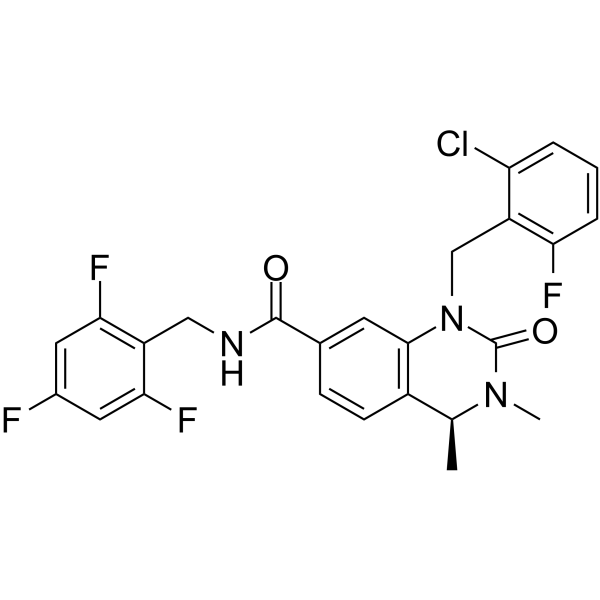
-
- HY-144328
-
|
|
STING
|
Inflammation/Immunology
Cancer
|
|
STING agonist-10 (Compound 91) is a potent small molecule cyclic urea activator of STING with the EC50 of 2600 nM. Activation of STING is a highly promising approach in immunotherapy .
|
-
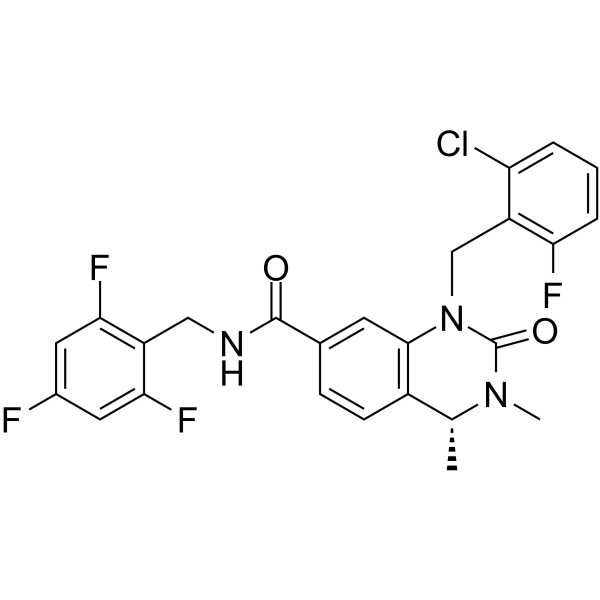
-
- HY-162465
-
|
|
STING
|
Infection
Inflammation/Immunology
Cancer
|
|
BDW568 is a STING agonist that can selectively activate the human STING A230 allele. BDW568 can be used to activate STING A230-engineered macrophages in macrophage-based immunotherapy .
|
-
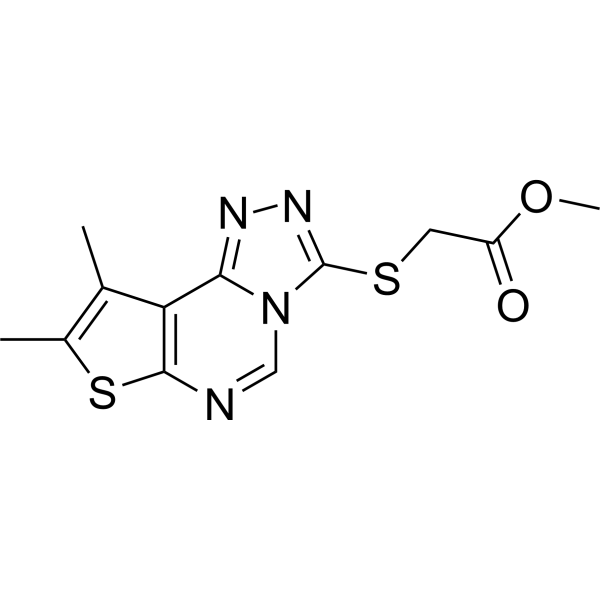
-
- HY-152960
-
|
|
STING
|
Infection
|
|
STING agonist-27 (CF509) is a non-nucleotide small-molecule STING agonist. STING agonist-23 activates STING, exhibits activity against SARS-CoV series strains .
|
-
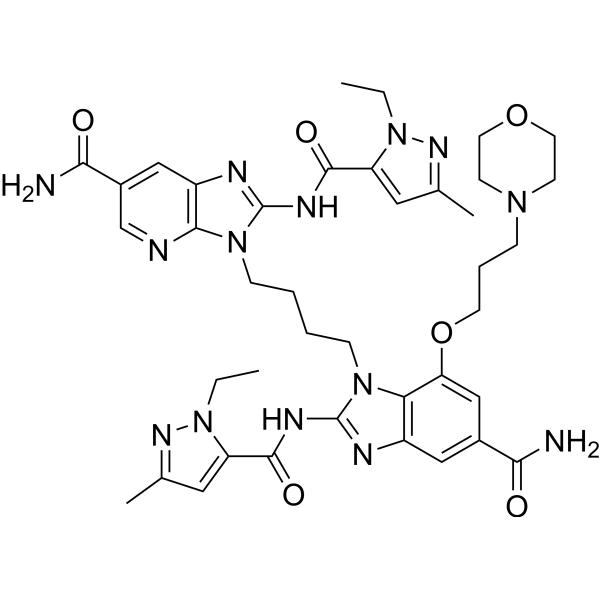
-
- HY-152962
-
|
|
STING
|
Infection
|
|
STING agonist-29 (CF511) is a non-nucleotide small-molecule STING agonist. STING agonist-23 activates STING, exhibits activity against SARS-CoV series strains .
|
-
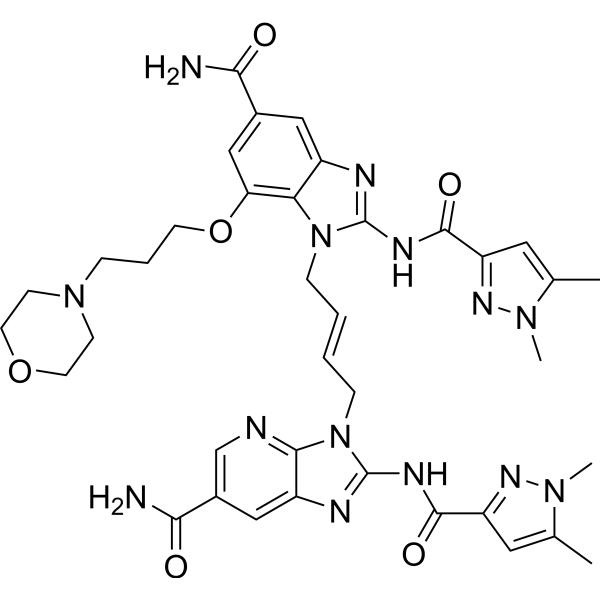
-
- HY-151970
-
|
|
STING
|
Inflammation/Immunology
|
|
STING-IN-4 (Compound 1) is a STING inhibitor that inhibits STING expression and hence reducing activation of STING and nuclear factor-κB (NF-κB) signaling. STING-IN-4 shows anti-inflammatory activity and can be used for the research of sepsis .
|
-
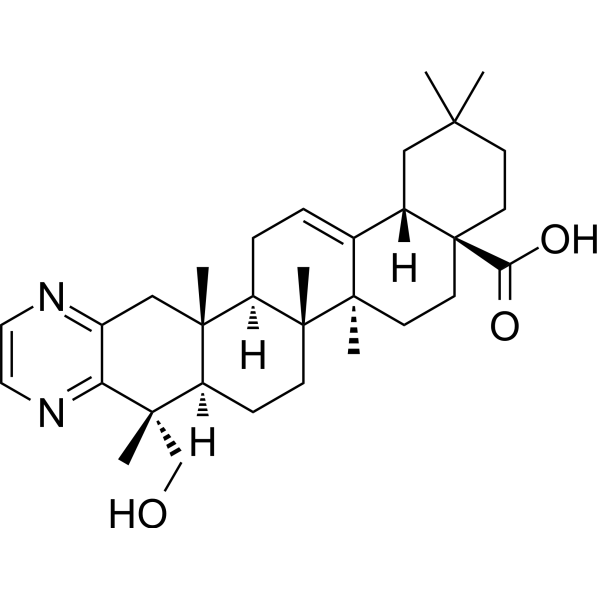
-
- HY-147010
-
-
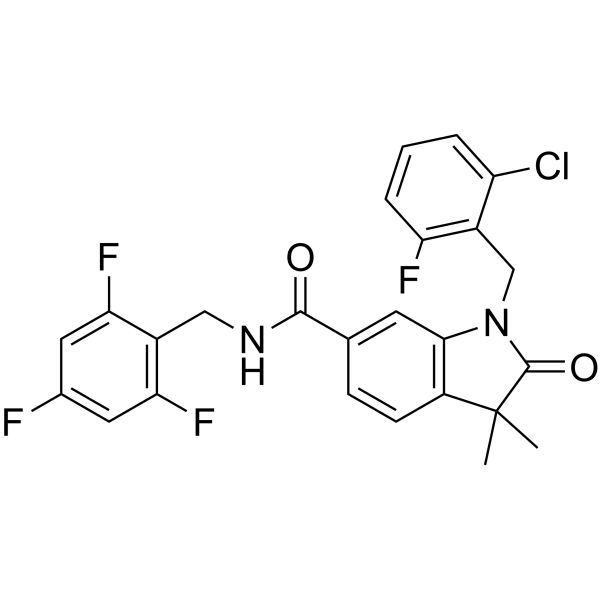
-
- HY-139179
-
|
|
STING
|
Infection
Cancer
|
|
STING agonist-14 (compound 12b) is a potent STING agonist that is efficacious across species. STING agonist-14 could activate the pathway by directly binding human STING. STING agonist-14 can be used for the research of tumours or viral infections .
|
-
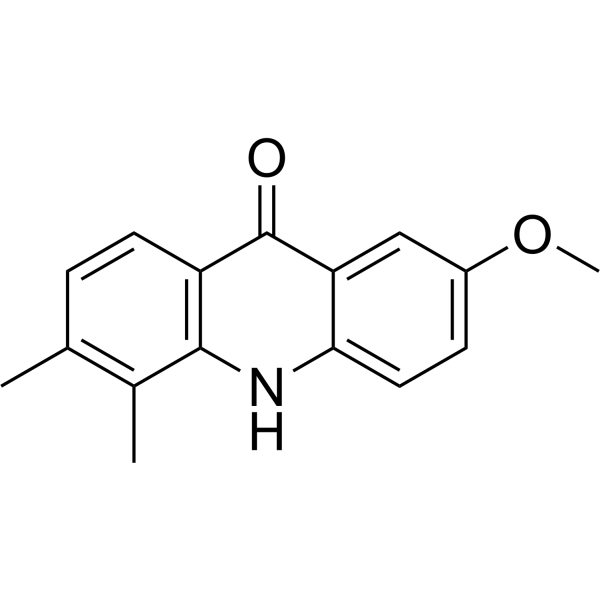
-
- HY-138683
-
|
|
STING
|
Inflammation/Immunology
|
|
STING-IN-3 is an inhibitor of stimulator of interferon genes (STING). STING-IN-3 efficiently inhibits both hsSTING and mmSTING through covalently target the predicted transmembrane cysteine residue 91 and thereby block the activation-induced palmitoylation of STING .
|
-
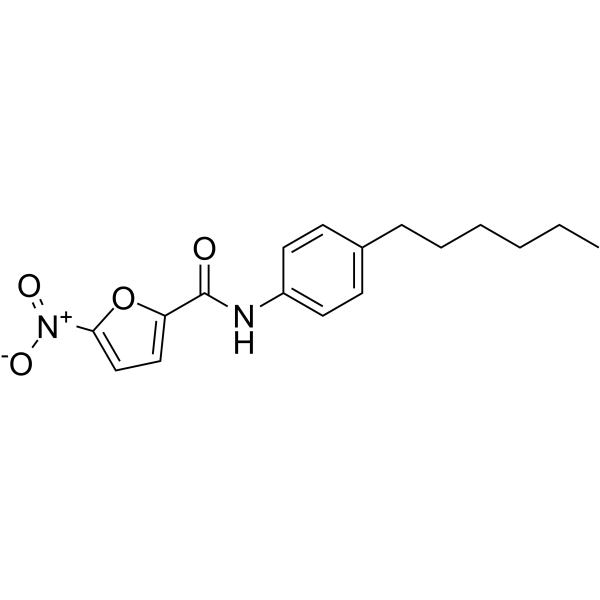
-
- HY-148606
-
|
|
STING
|
Cancer
|
|
STING modulator-3 is a STING inhibitor. STING modulator-3 inhibits R232 STING with an Ki value of 43.1 nM in scintillation proximity assay. STING modulator-3 has no effect on IRF-3 activation or TNF-β induction in THP-1 cells .
|
-

-
- HY-145010
-
SN-011
2 Publications Verification
|
STING
|
Inflammation/Immunology
|
|
SN-011 is a potent and selective mouse and human STING inhibitor, with an IC50 of 76 nM for STING signaling. SN-011 competes with cyclic dinucleotide (CDN) for the binding pocket of the STING dimer, blocking CDN binding and STING activation. SN-011 can be used for the research of STING-driven autoimmune and inflammatory disease .
|
-

-
- HY-143321
-
|
|
STING
|
Cancer
|
|
STING agonist-13 is a stimulator of interferon genes (STING) agonist, for cancer immunity via STING-mediated immune activation. STING agonist-13 can stimulate STING downstream signaling and promoting type I interferon immune responses. STING agonist-13 significantly decreases tumor volume and shows immunological memory-derived cancer inhibition .
|
-
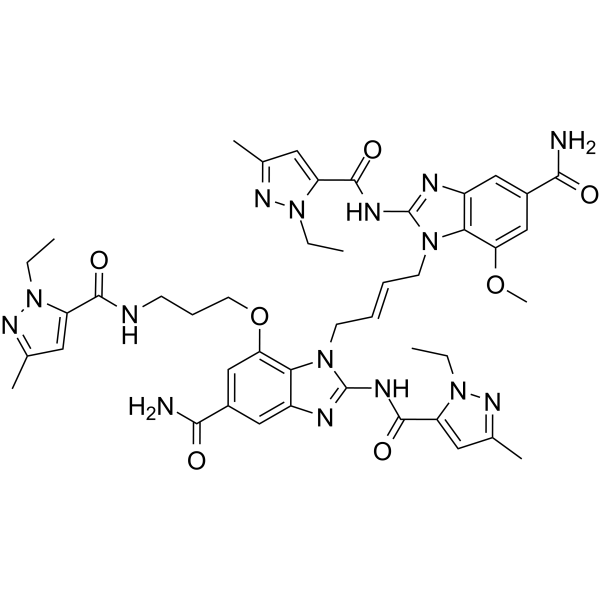
-
- HY-149267
-
|
|
STING
SARS-CoV
|
Infection
|
|
STING agonist-30 is a potent STING agonist. STING agonist-30 exhibits STING-dependent immune activation. STING agonist-30 has extensive inhibitory effects on various viruses, including the herpes simplex virus (HSV), rotavirus, and severe acute respiratory syndrome coronavirus 2 (SARS-CoV-2) .
|
-

-
- HY-152956
-
|
|
STING
|
Infection
|
|
STING agonist-23 (CF502) is a non-nucleotide small-molecule STING agonist. STING agonist-23 activates STING, increases phosphorylation of STING, TBK1 and IRF3. STING agonist-23 promotes the levels of IFN-β, IL-6, CXCL-10, TNF-α, ISG-15, and CCL-5 in tumor cells. STING agonist-23 exhibits activity against SARS-CoV series strains .
|
-

-
- HY-152957
-
|
|
STING
|
Infection
|
|
STING agonist-24 (CF504) is a non-nucleotide small-molecule STING agonist. STING agonist-23 activates STING, increases phosphorylation of STING, TBK1 and IRF3. STING agonist-23 promotes the levels of IFN-β, IL-6, CXCL-10, TNF-α, ISG-15, and CCL-5 in tumor cells. STING agonist-23 exhibits activity against SARS-CoV series strains .
|
-
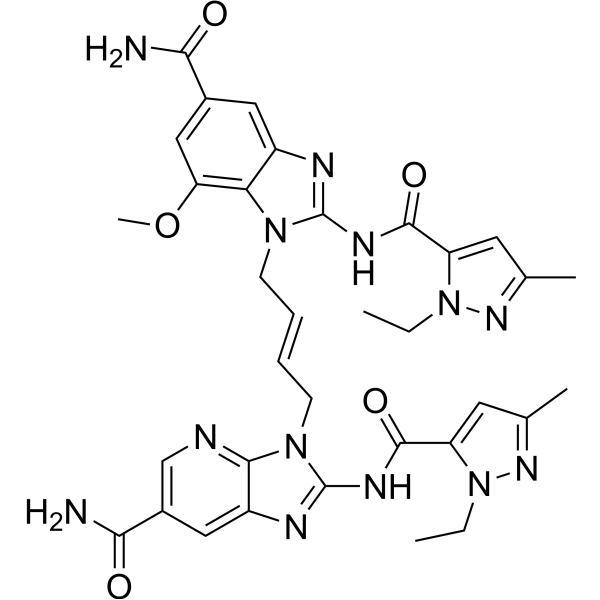
-
- HY-152958
-
|
|
STING
|
Infection
|
|
STING agonist-25 (CF505) is a non-nucleotide small-molecule STING agonist. STING agonist-23 activates STING, increases phosphorylation of STING, TBK1 and IRF3. STING agonist-23 promotes the levels of IFN-β, IL-6, CXCL-10, TNF-α, ISG-15, and CCL-5 in tumor cells. STING agonist-23 exhibits activity against SARS-CoV series strains .
|
-
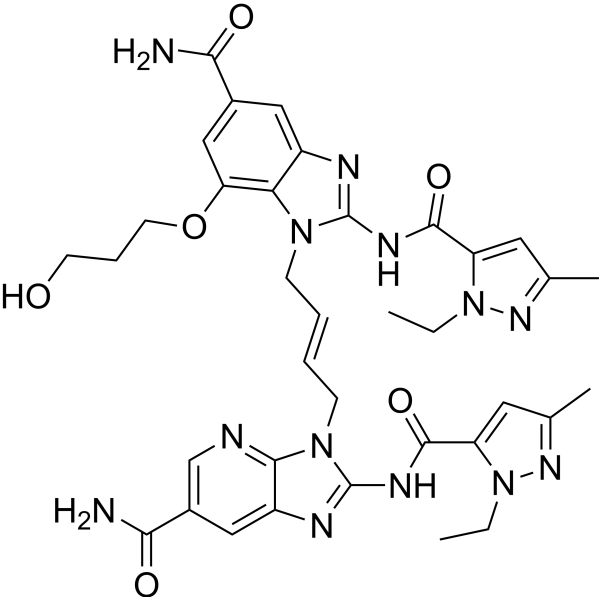
-
- HY-152959
-
|
|
STING
|
Infection
|
|
STING agonist-26 (CF508) is a non-nucleotide small-molecule STING agonist. STING agonist-23 activates STING, increases phosphorylation of STING, TBK1 and IRF3. STING agonist-23 promotes the levels of IFN-β, IL-6, CXCL-10, TNF-α, ISG-15, and CCL-5 in tumor cells. STING agonist-23 exhibits activity against SARS-CoV series strains .
|
-
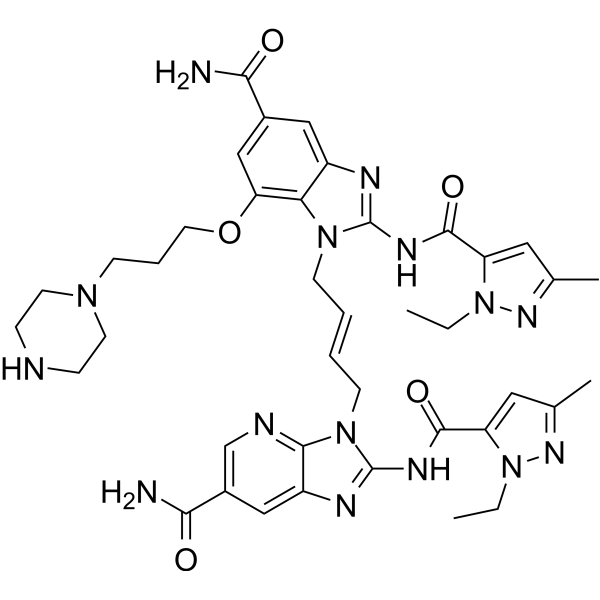
-
- HY-152961
-
|
|
STING
|
Infection
|
|
STING agonist-28 (CF510) is a non-nucleotide small-molecule STING agonist. STING agonist-23 activates STING, increases phosphorylation of STING, TBK1 and IRF3. STING agonist-23 promotes the levels of IFN-β, IL-6, CXCL-10, TNF-α, ISG-15, and CCL-5 in tumor cells. STING agonist-23 exhibits activity against SARS-CoV series strains .
|
-

-
- HY-152955
-
|
|
STING
|
Infection
Inflammation/Immunology
|
|
STING agonist-22 (CF501) is a potent non-nucleotide STING agonist. STING agonist-22 is a adjuvant by activating STING to induce the type I interferon (IFN-I) response and proinflammatory cytokine production. STING agonist-22 can be used as an adjuvant to boost the original protein vaccine, producing potent, broad, and long-term immune protection. STING agonist-22 can be used for SARS-CoV-2 variants and sarbecovirus diseases research .
|
-
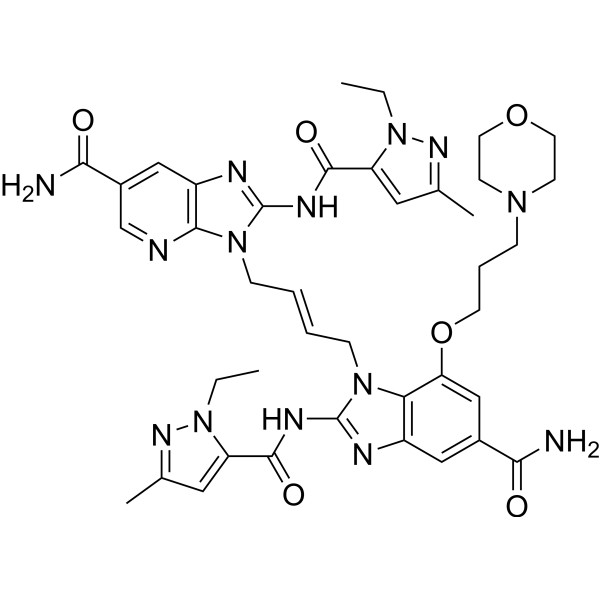
-
- HY-123963
-
C-178
4 Publications Verification
|
STING
|
Inflammation/Immunology
|
|
C-178 is a potent and selective covalent inhibitor of STING. C-178 binds to Cys91 and suppresses the STING responses elicited by distinct bona fide activators in mouse but not human .
|
-

-
- HY-112906
-
C-176
Maximum Cited Publications
51 Publications Verification
|
STING
|
Inflammation/Immunology
|
|
C-176 is a selective and blood-brain barrier permeable STING inhibitor. C-176 covalently targets transmembrane cysteine residue 91 and thereby blocking activation-induced palmitoylation of STING .
|
-
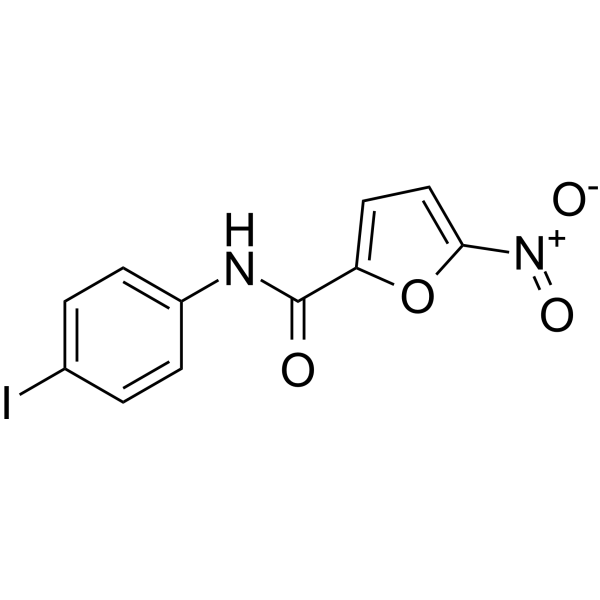
-
- HY-12885A
-
|
MIW815 disodium salt; ML RR-S2 CDA disodium salt
|
|
|
|
ADU-S100 disodium salt (MIW815 disodium salt) is an activator of stimulator of interferon genes (STING).
|
-
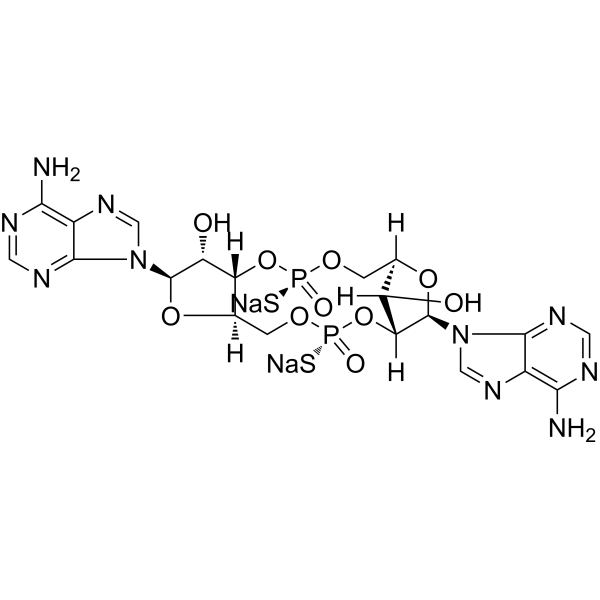
-
- HY-162133
-
|
|
STING
|
Cancer
|
|
MSA-2-Pt is an orally active STING agonist that has good cell membrane permeability. MSA-2-Pt can induce cell death by Pt, which may release damaged DNA to activate the cGAS-STING pathway. Besides, MSA-2-Pt can activate the STING pathway directly by MSA-2. MSA-2-Pt can be used for the research of cancer .
|
-
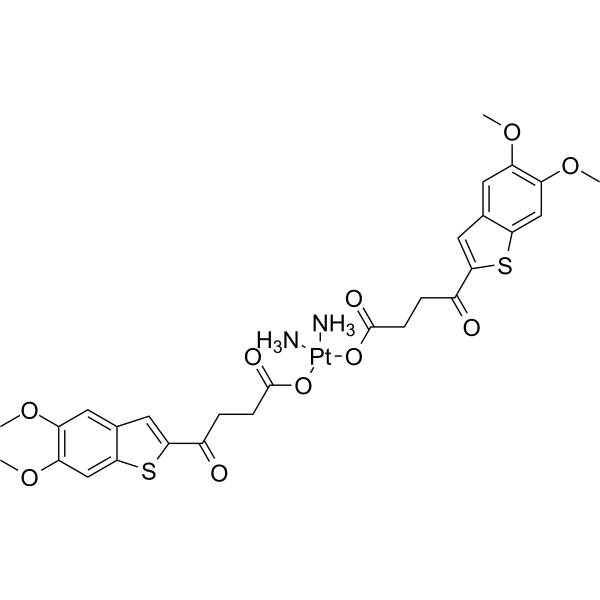
-
- HY-157214
-
|
|
STING
|
Cancer
|
|
NVS-STG2 is a molecular glue that targets STING and activates STING-mediated immune signaling. NVS-STG2 induces higher-order oligomerization of human STING by binding to pockets between adjacent STING dimer transmembrane domains, effectively acting as a molecular glue. NVS-STGI enhances the activity of cGAMP by inducing the formation of more abundant and larger oligomers. NVS-STG2 produces antitumor activity in animal models .
|
-

-
- HY-12885
-
|
MIW815; ML RR-S2 CDA
|
STING
|
Inflammation/Immunology
Cancer
|
|
ADU-S100 (MIW815), an activator of stimulator of interferon genes (STING), leads to potent and systemic tumor regression and immunity .
|
-

-
- HY-130116A
-
|
|
STING
|
Cancer
|
|
IACS-8779 disodium is a highly potent stimulator of interferon genes (STING) agonist with robust systemic antitumor efficacy. IACS-8779 disodium shows robust activation of the STING pathway in vitro and a superior systemic anti-tumor response in the B16 murine model of melanoma .
|
-
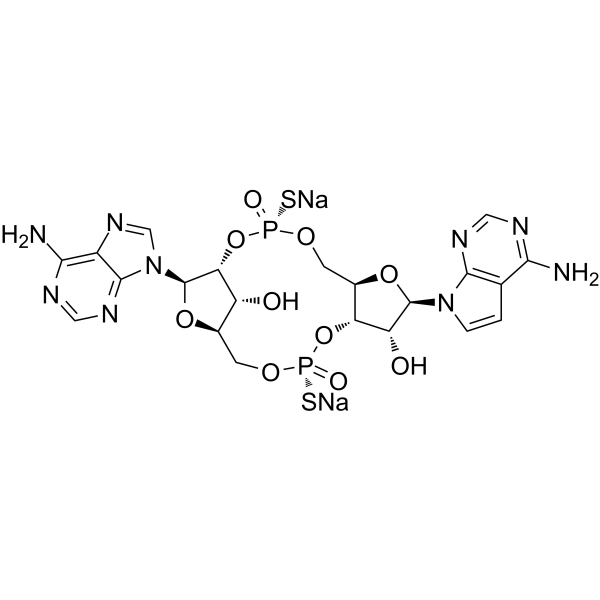
-
- HY-155100
-
|
|
STING
|
Inflammation/Immunology
Cancer
|
|
BI 7446 is a cyclic dinucleotide (CDN)-based potent and selective stimulator of interferon genes (STING) agonist. BI 7446 can activate all five STING variants in cells and induce tumor-specific immune-mediated tumor rejection. BI 7446 can be used for immuno-oncology research .
|
-

-
- HY-148029
-
|
TAK-676
|
STING
|
Cancer
|
|
Dazostinag disodium (TAK-676) is an agonist of STING, triggering the activation of STING signaling pathway and type I interferons. Dazostinag disodium is also a modulator of immune system, resulting complete regressions and durable memory T-cell immunity. Dazostinag disodium promotes durable IFN-dependent antitumor immunity .
|
-

-
- HY-12885B
-
|
MIW815 ammonium salt; ML RR-S2 CDA ammonium salt
|
STING
|
Inflammation/Immunology
Cancer
|
|
ADU-S100 ammonium salt (MIW815 ammonium salt), an activator of stimulator of interferon genes (STING), leads to potent and systemic tumor regression and immunity .
|
-
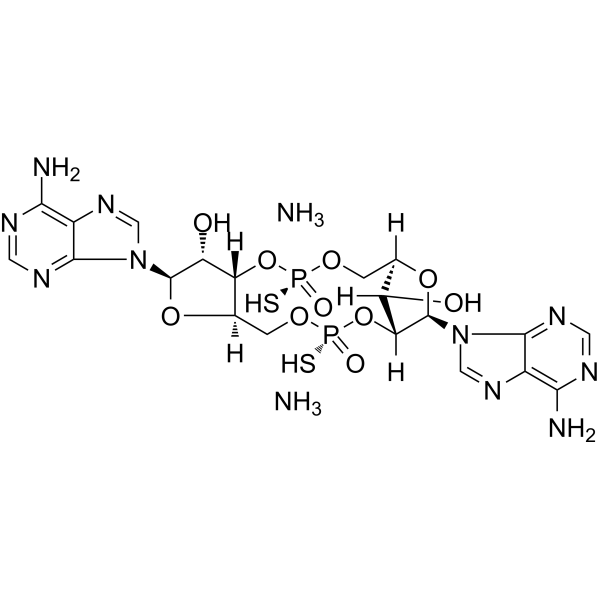
-
- HY-12212
-
|
RTA 408
|
Keap1-Nrf2
STING
Apoptosis
|
Inflammation/Immunology
Cancer
|
|
Omaveloxolone (RTA 408) is an antioxidant inflammation modulator (AIM), which activates Nrf2 and suppresses nitric oxide (NO). Omaveloxolone attenuates osteoclastogenesis by inhibiting STING dependent NF-κb signaling.
|
-
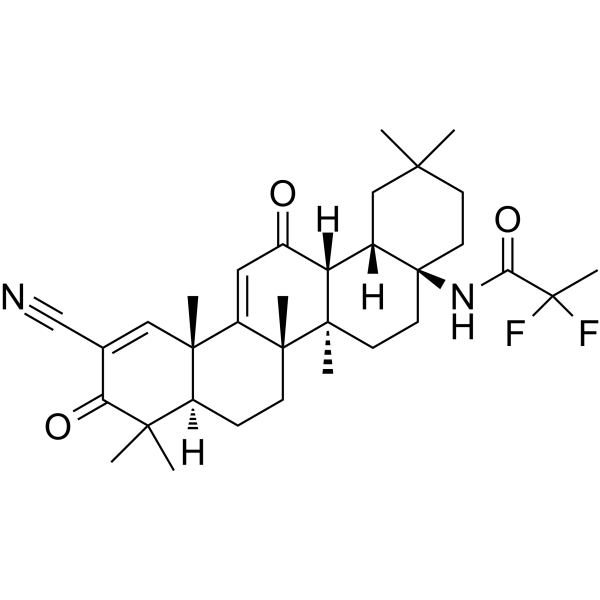
-
- HY-12885C
-
|
MIW815 enantiomer ammonium salt; ML RR-S2 CDA enantiomer ammonium salt
|
Others
|
Inflammation/Immunology
|
|
ADU-S100 enantiomer ammonium salt (MIW815 enantiomer ammonium salt) is the less active enantiomer of ADU-S100. ADU-S100 is an activator of stimulator of interferon genes (STING) .
|
-

-
- HY-12512
-
|
Cyclic GMP-AMP; 3',3'-cGAMP
|
STING
|
Inflammation/Immunology
|
|
cGAMP (Cyclic GMP-AMPP) functions as an endogenous second messenger in metazoans and triggers interferon production in response to cytosolic DNA. cGAMP activates stimulator of interferon genes (STING), which activates a signaling cascade leading to the production of type I interferons and other immune mediators .
|
-
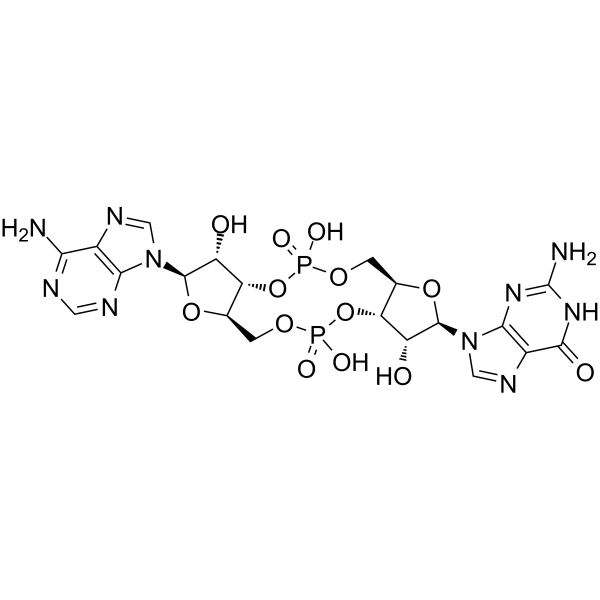
-
- HY-110385
-
|
Cyclic GMP-AMP disodium; 3',3'-cGAMP disodium
|
STING
Endogenous Metabolite
|
Inflammation/Immunology
|
|
cGAMP (Cyclic GMP-AMPP) disodium functions as an endogenous second messenger in metazoans and triggers interferon production in response to cytosolic DNA. cGAMP diammonium activates stimulator of interferon genes (STING), which activates a signaling cascade leading to the production of type I interferons and other immune mediators .
|
-
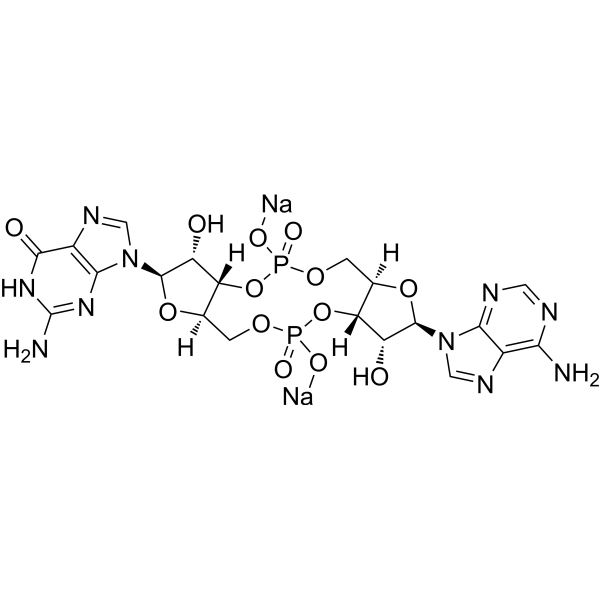
-
- HY-110385A
-
|
Cyclic GMP-AMP diammonium; 3',3'-cGAMP diammonium
|
STING
Endogenous Metabolite
|
Inflammation/Immunology
|
|
cGAMP (Cyclic GMP-AMPP) diammonium functions as an endogenous second messenger in metazoans and triggers interferon production in response to cytosolic DNA. cGAMP diammonium activates stimulator of interferon genes (STING), which activates a signaling cascade leading to the production of type I interferons and other immune mediators .
|
-

-
- HY-151513
-
|
|
Others
|
Cancer
|
|
Iso5-2DC18 is a lipid that can be used for the synthesis of amine containing lipids. These amine containing lipids can be used for mRNA delivery, activate the stimulator of interferon genes (STING) pathway, and exhibit anti-tumor immunity .
|
-
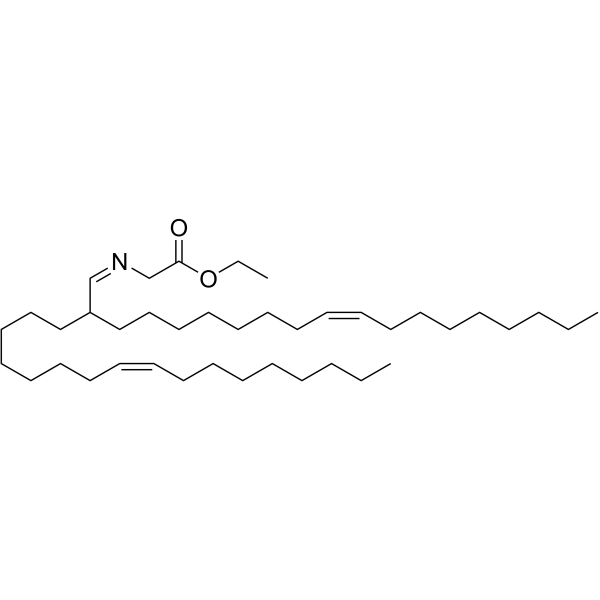
-
- HY-155109
-
|
|
STING
|
Inflammation/Immunology
Cancer
|
|
Antitumor agent-114 is a potent stimulator of interferon genes (STING) agonist. Antitumor agent-114 activates immunity and reduces tumor volume in a mouse model of breast cancer. Antitumor agent-114 can be used for immunity and cancer diseases research .
|
-
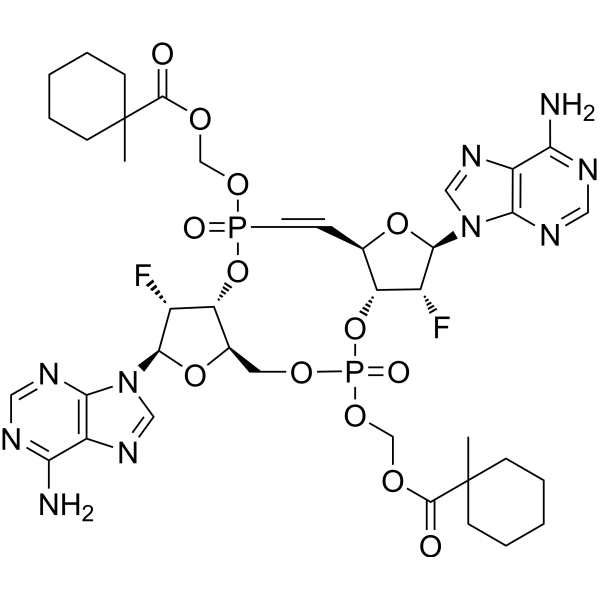
-
- HY-10249
-
|
|
Akt
AMPK
Autophagy
|
Cancer
|
|
GSK-690693 is an ATP-competitive pan-Akt inhibitor with IC50s of 2 nM, 13 nM, 9 nM for Akt1, Akt2 and Akt3, respectively. GSK-690693 is also an AMPK inhibitor, affects Unc-51-like autophagy activating kinase 1 (ULK1) activity and robustly inhibits STING-dependent IRF3 activation .
|
-
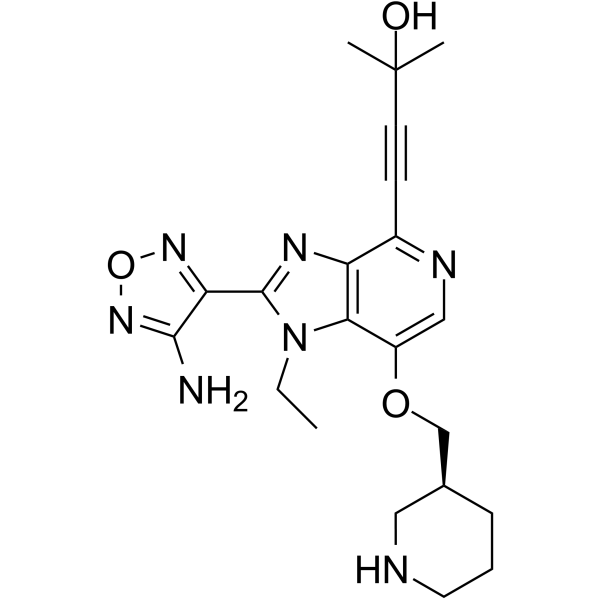
-
- HY-12326A
-
|
Cyclic diadenylate disodium; Cyclic-di-AMP disodium
|
STING
Bacterial
Endogenous Metabolite
|
Inflammation/Immunology
|
|
c-di-AMP (Cyclic diadenylate) sodium is a STING agonist, which binds to the transmembrane protein STING thereby activating the TBK3-IRF3 signaling pathway, subsequently triggering the production of type I IFN and TNF. c-di-AMP sodium is also a bacterial second messenger, which regulates cell growth, survival, and virulence, primarily within Gram-positive bacteria, and also regulates host immune response. c-di-AMP sodium acts as a potent mucosal adjuvant stimulating both humoral and cellular responses .
|
-

-
- HY-12326B
-
|
Cyclic diadenylate diammonium; Cyclic-di-AMP diammonium
|
STING
Bacterial
Endogenous Metabolite
|
Inflammation/Immunology
|
|
c-di-AMP diammonium is a STING agonist, which binds to the transmembrane protein STING thereby activating the TBK3-IRF3 signaling pathway, subsequently triggering the production of type I IFN and TNF. c-di-AMP diammonium is also a bacterial second messenger, which regulates cell growth, survival, and virulence, primarily within Gram-positive bacteria, and also regulates host immune response. c-di-AMP diammonium acts as a potent mucosal adjuvant stimulating both humoral and cellular responses .
|
-
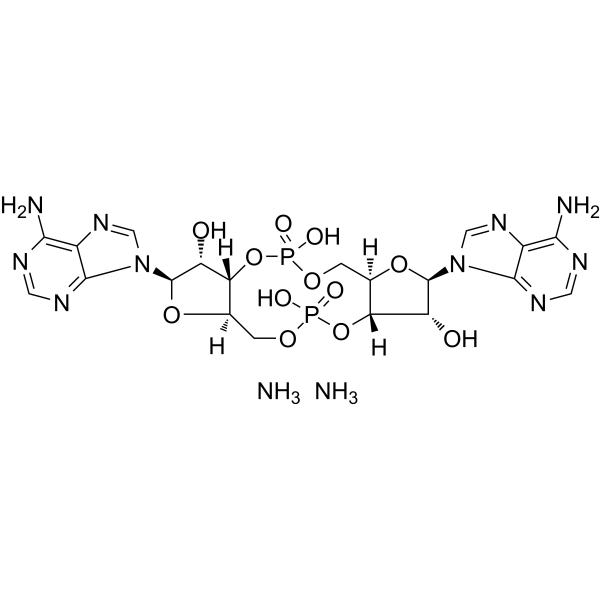
-
- HY-12326
-
|
Cyclic diadenylate; Cyclic-di-AMP
|
STING
Bacterial
Endogenous Metabolite
|
Inflammation/Immunology
|
|
c-di-AMP (Cyclic diadenylate) is a STING agonist, which binds to the transmembrane protein STING thereby activating the TBK3-IRF3 signaling pathway, subsequently triggering the production of type I IFN and TNF. c-di-AMP (Cyclic diadenylate) is also a bacterial second messenger, which regulates cell growth, survival, and virulence, primarily within Gram-positive bacteria, and also regulates host immune response. c-di-AMP (Cyclic diadenylate) acts as a potent mucosal adjuvant stimulating both humoral and cellular responses .
|
-

-
- HY-12326R
-
|
Cyclic diadenylate (Standard); Cyclic-di-AMP (Standard)
|
STING
Bacterial
Endogenous Metabolite
|
Inflammation/Immunology
|
|
c-di-AMP (Standard) is the analytical standard of c-di-AMP. This product is intended for research and analytical applications. c-di-AMP (Cyclic diadenylate) is a STING agonist, which binds to the transmembrane protein STING thereby activating the TBK3-IRF3 signaling pathway, subsequently triggering the production of type I IFN and TNF. c-di-AMP (Cyclic diadenylate) is also a bacterial second messenger, which regulates cell growth, survival, and virulence, primarily within Gram-positive bacteria, and also regulates host immune response. c-di-AMP (Cyclic diadenylate) acts as a potent mucosal adjuvant stimulating both humoral and cellular responses .
|
-
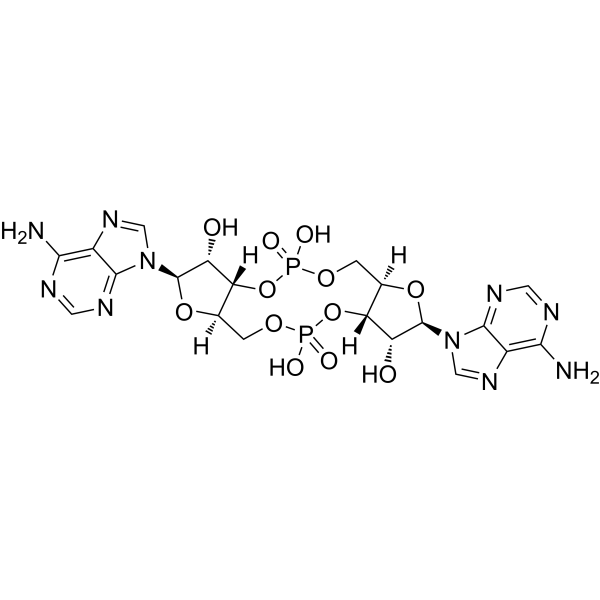
-
- HY-160222
-
|
|
HSV
STING
|
Infection
Inflammation/Immunology
|
|
HSV-60mer sodium is a 60 bp double-stranded oligonucleotide containing viral DNA motifs that derive from the herpes simplex virus 1 (HSV-1) genome . Transfected HSV-60 has been shown to potently induce IFN-β in a Toll-like receptor (TLR)-, DNA-dependent activator of IRFs (DAI)-, and RNA polymerase III (Pol III)-independent, but STING-, TBK1- and IFN regulatory factor 3 (IRF3)-dependent manner.
|
-
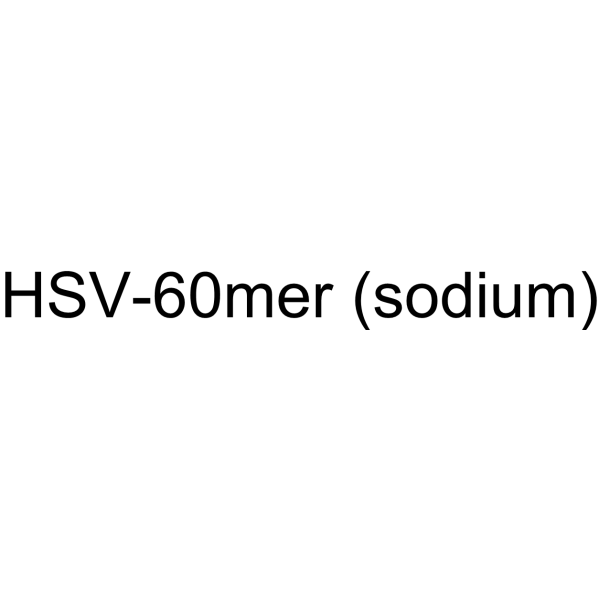
-
-
HY-L031
-
|
|
486 compounds
|
|
Immuno-Oncology is a type of immunotherapy that has the specific purpose of treating cancer. It works by stimulating our immune system to fight back. Normally, our immune system is able to destroy cancer cells in our body, however sometimes cancer cells can adapt and mutate, effectively hiding from our immune system. This is when tumors can develop and become a threat to our health. Immuno-oncology involves mobilizing lymphocytes to recognize and eliminate cancer cells using the body’s immune system. There are several immuno-oncology treatments available, including Immune cell therapy (CAR-T), monoclonal antibodies (mABs) and checkpoint inhibitors, cytokines and cancer vaccines.
MCE Small Molecule Immuno-Oncology Compound Library offers 486 bioactive tumor immunology compounds that target some important checkpoints such as PD1/PD-L1, CXCR, Sting, IDO, TLR, etc. This library is a useful tool for Immuno-oncology research.
|
| Cat. No. |
Product Name |
Category |
Target |
Chemical Structure |
Your information is safe with us. * Required Fields.
Inquiry Information
- Product Name:
- Cat. No.:
- Quantity:
- MCE Japan Authorized Agent:


















































